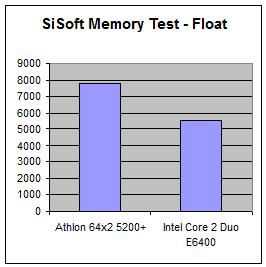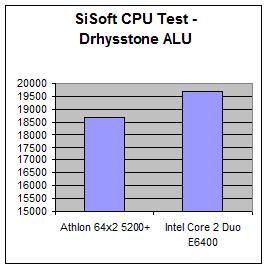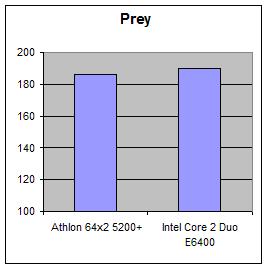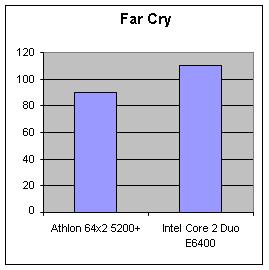Hi Everybody…
I have been disparaged by most of my friends and colleagues after I bought a laptop with AMD Athlon 64×2 processor. According to them AMD processors are no where near the Intel processors when it come to performance and price. So in this post I will just present a small comparison of both these processors just to make my friends think little different.
I was aware that after the launch of Intel’s Core 2 Duo, AMD has been struggling but still I preferred to go with AMD. Reason being, firstly, I want to see how AMD work, secondly it’s cheap.
 Today, Intel has the crown in terms of both power and efficiency. AMD recently cut the prices for its top end processor, the Athlon 64×2 5200+, by a dramatic 50 per cent, hence making it affordable for the average customer. The landmark had drawn hard talk’s interest and today the AMD Athlon 64×2 will be pitted against its closest rival (at least in terms of price), the Intel core 2 duo E6400.
Today, Intel has the crown in terms of both power and efficiency. AMD recently cut the prices for its top end processor, the Athlon 64×2 5200+, by a dramatic 50 per cent, hence making it affordable for the average customer. The landmark had drawn hard talk’s interest and today the AMD Athlon 64×2 will be pitted against its closest rival (at least in terms of price), the Intel core 2 duo E6400.
It would be unfair to not to attribute AMD for its competitive offerings in the form of Athlon 64 and Athlon 64×2 that forced Intel to start building the Core 2 Duo processor series. It was AMD’s revolutionary efforts for 64 bit operating systems, lower power consumption and better support for the multi-core processors that ushered into a new era that was being resisted heavily by Intel. In fact it can be said safely that if it were not AMD, the market would still be sitting at peaked out and inefficient dual core systems, consuming enough power to light up a house.
64×2 that forced Intel to start building the Core 2 Duo processor series. It was AMD’s revolutionary efforts for 64 bit operating systems, lower power consumption and better support for the multi-core processors that ushered into a new era that was being resisted heavily by Intel. In fact it can be said safely that if it were not AMD, the market would still be sitting at peaked out and inefficient dual core systems, consuming enough power to light up a house.
To compare both of these processors lets have a look at their performance using renowned benchmarks. (I personally have not benchmarked these processors, just presenting a summary of few existing results on the web that I have researched).
1. Memory benchmark
The SiSoft 2007 memory benchmark is the predefined standard upon which CPUs are measured for theoretical speed increments. Memory performance details like how wide the pipeline of information is present in between the system and the CPU.
Flow of information depends upon the bandwidth, hence removing any potential bottlenecks for the processor to perform tasks. During the test, both processors were equipped with PC 5400 DDR-2 RAM from Kingston and then examined thoroughly with and intensive memory test.
Due to the presence of Hyper Transport memory controller, inside the CPU itself, the Athlon 64 X2 5200+ makes its mark in this synthetic test leaving the Core 2 Duo behind in a trail of dust.
It can be be proved mathematically as follows:
Intel’s FSB = 64bits X 800MHz/8 = 6,400Mb/s.
AMD’s HTT= 32bits X 1000MHz X 2 (double- pumped)/8 = 8,0000Mb/s.
2. CPU Benchmark
Using SiSoft’s CPU benchmark, both the processors where again pitted against each other in a theoretical setup, presented by the benchmark suite.
The Intel core 2 duo edge slightly ahead of the AMD athlon 64×2 in this test but does not prove anything conclusive regarding the efficiency of processing in either of the present platform.
3. Prey
It is in the gaming benchmarks that the Intel E5400 gets ahead in comparison to the Athlon 64×2 5200+ processor. The test bed system was GeForce 8800 GTX graphics card running with two gigabyte of DDR2 RAM. The default resolution of 1024*768 was used as the lower resolution give more headway for the CPU to perform and the graphical processing unit does not present any bottleneck for the frames per second to roll out. First in line is the OpenGL powered Prey, a game based on Doom 3 engine.
They prey results did not show any significant difference between the two processors, which indicates the relatively close performance between the two brands.
4. Far Cry
In order to see the difference of performance between the two processors better, Far Cry a relatively older title was used. Core 2 Duo processor stood heads and shoulders above the Athlon 64 X2 5200+. The Far Cry physics engine is extremely processor intensive, and the Athlon 64×2 5200+ is definitely lagging behind by a good 20 frames per second, which can prove to quite worrying if the physics are dumped heavily on this processor.
5. Conclusion
Given the two synthetic and two real world benchmarks, there is not a lot which goes against the Athlon 54 X2 5200+. The Intel offering is definitely superior, but given the relatively close prices of each, the performance differences are really marginal and in the end boils down to one’s own taste for either brand. If one is AMD fan, then the AMD Athlon 64×2 5200+ will more than fit the requirement for a performance processor in comparison to the Intel Core 2 Duo E6400 processor.
Few References:
1. http://www.itp.net/index.php?option=com_content&view=article&id=493585&Itemid=1
2. http://www.gamingparents.org/index.php?option=com_content&task=view&id=173&Itemid=64
3. http://en.wikipedia.org/wiki/Athlon
4. http://en.wikipedia.org/wiki/Core_2_duo
—
Keep Smiling 🙂





